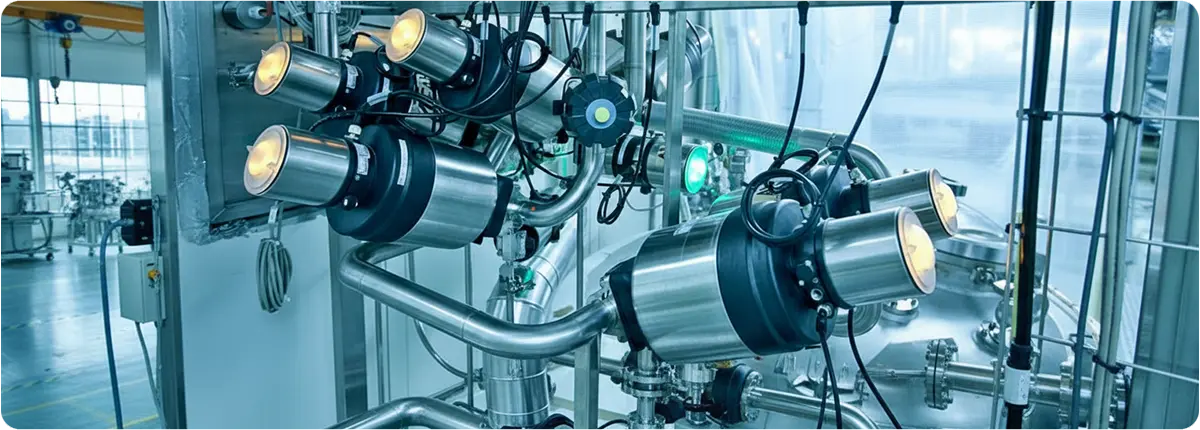The dairy industry is one of the most demanding sectors in terms of hygiene, efficiency, and reliability. Every step of milk processing — from collection and pasteurization to the production of cheese, yogurt, butter, and other dairy products — relies heavily on fluid handling systems. Among these, valves play a critical role in ensuring safe product flow, hygienic processing, and system reliability.
Valves not only control the direction, pressure, and flow of liquids but also protect against contamination, mixing of incompatible products, and potential equipment damage. Choosing the right valve is therefore crucial for maintaining product quality, food safety compliance, and plant productivity.

COMMON TYPES OF VALVES IN THE DAIRY INDUSTRY
- Butterfly Valves: Compact, lightweight, cost-effective, and easy to clean. Used in milk transfer pipelines, yogurt lines, and low- to medium-pressure processes. Polished stainless steel and FDA-approved seals ensure hygiene.
- Ball Valves: Provide quick shut-off and full bore flow. Suitable for cream transfer and CIP (Clean-in-Place) circuits. Special sanitary designs prevent cleaning issues.
- Diaphragm Valves: Ideal for aseptic processes with flexible diaphragm sealing. Common in fermentation tanks and probiotic milk processing lines.
- Mix-Proof (Double Seat) Valves: Allow two different fluids to flow without mixing. Essential in multi-product pipelines handling milk, whey, and cleaning agents alternately.
- Check Valves: Prevent reverse flow, ensuring pump and process protection.
- Safety Valves: Protect systems from overpressure in pasteurizers, CIP tanks, and storage vessels.
MATERIAL SELECTION AND HYGIENIC STANDARDS
Since dairy valves come into direct contact with food products, material selection is vital. Stainless Steel 316L is preferred for its corrosion resistance and durability against cleaning chemicals. Sealing materials include EPDM, FKM, or PTFE. Surface finishes should meet ≤ Ra 0.8 µm to ensure hygiene compliance.
Key Standards:
- FDA – Material compliance for food safety.
- 3-A Sanitary Standards – Hygienic design for dairy equipment.
- EHEDG – Certification for hygienic processing equipment.
APPLICATION EXAMPLES IN DAIRY PROCESSING
| Process Step | Preferred Valve Types | Key Considerations |
|---|---|---|
| Milk reception | Butterfly valves, check valves | Easy operation, prevent backflow |
| Pasteurization | Mix-proof, diaphragm valves | Aseptic conditions, temperature resistance |
| Yogurt & cheese making | Diaphragm, mix-proof valves | Hygienic separation of product and CIP |
| CIP/SIP cleaning | Ball valves, butterfly valves | Leak-free design, chemical compatibility |
| Storage tanks | Safety valves, level control | Pressure relief, product safety |
AUTOMATION AND SMART VALVE CONTROL
Modern dairy plants integrate valves with pneumatic or electric actuators for remote operation. Valve control heads provide position feedback, while PLC/SCADA systems enable automated cleaning cycles, routing, and monitoring. Automation boosts efficiency, safety, and traceability in large-scale production.
SELECTION CRITERIA FOR DAIRY VALVES
- Hygiene compliance (FDA, EHEDG, 3-A certifications)
- Cleanability (CIP/SIP compatibility, no dead zones)
- Durability (chemical and temperature resistance)
- Flow requirements (full bore vs. throttling)
- Automation needs (manual vs. actuated)
- Cost vs. lifecycle performance
CONCLUSION
Valves are essential in the dairy industry, influencing hygiene, product quality, and operational efficiency. Selecting the right valve type — whether butterfly, ball, diaphragm, mix-proof, or safety — ensures smooth production and compliance with international food safety standards. As automation and digitalization advance, valves evolve into smart, integrated components that enhance sustainability, efficiency, and reliability.
